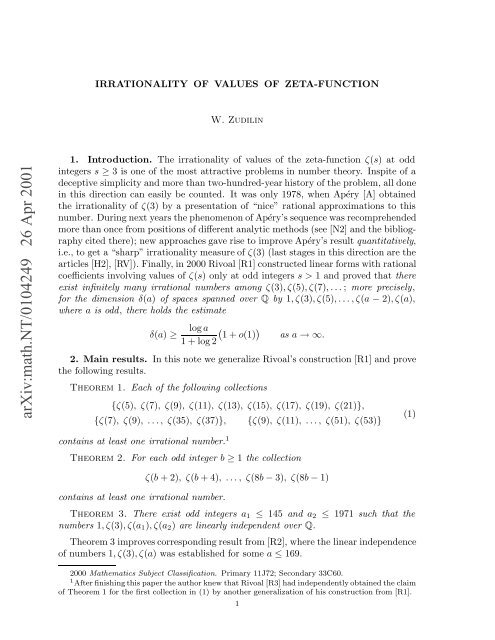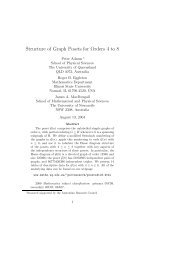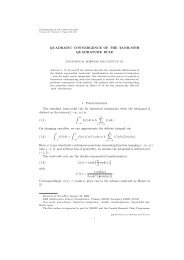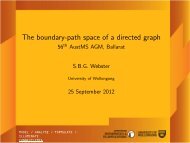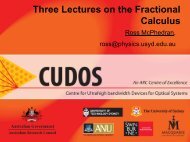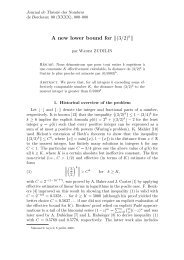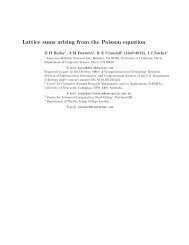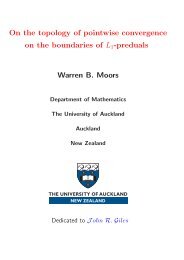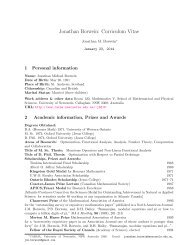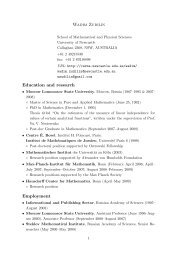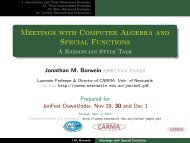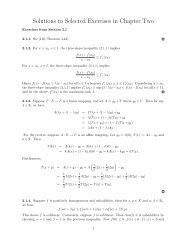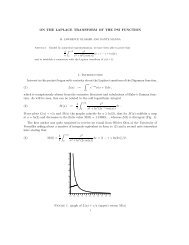a, c - Wadim Zudilin
a, c - Wadim Zudilin
a, c - Wadim Zudilin
Create successful ePaper yourself
Turn your PDF publications into a flip-book with our unique Google optimized e-Paper software.
IRRATIONALITY OF VALUES OF ZETA-FUNCTIONW. <strong>Zudilin</strong>arXiv:math.NT/0104249 26 Apr 20011. Introduction. The irrationality of values of the zeta-function ζ(s) atoddintegers s ≥ 3 is one of the most attractive problems in number theory. Inspite of adeceptive simplicity and more than two-hundred-year history of the problem, all donein this direction can easily be counted. It was only 1978, when Apéry [A] obtainedthe irrationality of ζ(3) by a presentation of “nice” rational approximations to thisnumber. During next years the phenomenon of Apéry’s sequence was recomprehendedmore than once from positions of different analytic methods (see [N2] and the bibliographycited there); new approaches gave rise to improve Apéry’s result quantitatively,i.e., to get a “sharp” irrationality measure of ζ(3) (last stages in this direction are thearticles [H2], [RV]). Finally, in 2000 Rivoal [R1] constructed linear forms with rationalcoefficients involving values of ζ(s) only at odd integers s>1 and proved that thereexist infinitely many irrational numbers among ζ(3),ζ(5),ζ(7),...; more precisely,for the dimension δ(a) of spaces spanned over Q by 1,ζ(3),ζ(5),...,ζ(a − 2),ζ(a),where a is odd, there holds the estimateδ(a) ≥log a ( )1+o(1) as a →∞.1+log22. Main results. In this note we generalize Rivoal’s construction [R1] and provethe following results.Theorem 1. Each of the following collections{ζ(5), ζ(7), ζ(9), ζ(11), ζ(13), ζ(15), ζ(17), ζ(19), ζ(21)},{ζ(7), ζ(9), ..., ζ(35), ζ(37)}, {ζ(9), ζ(11), ..., ζ(51), ζ(53)}(1)contains at least one irrational number. 1Theorem 2. For each odd integer b ≥ 1 the collectionζ(b +2),ζ(b +4), ..., ζ(8b − 3), ζ(8b − 1)contains at least one irrational number.Theorem 3. There exist odd integers a 1 ≤ 145 and a 2 ≤ 1971 such that thenumbers 1,ζ(3),ζ(a 1 ),ζ(a 2 ) are linearly independent over Q.Theorem 3 improves corresponding result from [R2], where the linear independenceof numbers 1,ζ(3),ζ(a) was established for some a ≤ 169.2000 Mathematics Subject Classification. Primary 11J72; Secondary 33C60.1 After finishing this paper the author knew that Rivoal [R3] had independently obtained the claimof Theorem 1 for the first collection in (1) by another generalization of his construction from [R1].1
2 W. ZUDILINTheorem 4. For each odd integer a ≥ 3 there holds the absolute estimateδ(a) > 0.395 log a> 2 3 ·log a1+log2 . (2)We stress that our proofs of Theorems 1–4 exploit calculations via the saddle pointmethod (Section 4) and ideologically leans on the works [N2], [He]. An improvelmentof arithmetic estimates (i.e., of denominators of numerical linear forms) in the spiritof [H2], [RV] (Section 3) allows us to sharpen the lower estimate of δ(a) inTheorems3, 4 for small values of a. In Section 5 we obtain not only an upper bound butalso precise asymptotics of coefficients of linear forms. Finally, we prove Theorems 1–4in Section 6.The main results of the work were announced in the communication [Z].The author is grateful to Professor Yu. V. Nesterenko for his permanent attentionto the work. This research was carried out with the partial support of the INTAS–RFBR grant no. IR-97-1904.3. Analytic construction. We fix positive odd parameters a, b, c such that c ≥ 3,a>b(c − 1), and for each positive integer n consider the rational functionR(t) =R n (t) :=((t ± (n +1))···(t ± cn)) b(t(t ± 1) ···(t ± n)) a · (2n)! a+b−bc( ) b sin πt=(−1) n · · Γ(±t + cn +1)b Γ(t − n) a+b· (2n)! a+b−bc ,πΓ(t + n +1) a+b (3)where the record ‘±’ means that the product contains factors corresponding both toasign‘+’andtoa‘−’. To the function (3) assign the infinite sumI = I n :=∞∑t=n+11 d b−1 R(t); (4)(b − 1)! dt b−1the series on the right-hand side of (4) converges absolutely since R(t) =O(t −2 )ast →∞. Decomposing the function (3) in a sum of partial fractions and using itsoddness, we deduce thatI =∑A s ζ(s) − A 0 (5)s is oddb
IRRATIONALITY OF ZETA-VALUES 3Lemma 1. For each odd integer c ≥ 3 there exists a sequence of integers Π n =Π n,c ≥ 1, n =1, 2,..., such that the numbers Π −bn Da+b−1 2n A s,n are integral and thelimit relationlog Π n,cϖ c := limn→∞ n= −(c−1)/2∑l=1( ( ) ( )2l 2l2ψ +2ψc − 1 c+ 2c − 1 )+2(c − 1)(1 − γ)l(6)holds; here γ ≈ 0.57712 is Euler’s constant and ψ(x) is the logarithmic derivative ofthe gamma-function.Proof. Let∏{}Π n =p ν p(cn + k)! (cn − k)!, where ν p = min ord p√ k=0,±1,...,±n (n + k)! c (n − k)! c .(c+1)n √ (c +1)n there holdsnν p =min c( ϕ|k|≤n p , k ),p
4 W. ZUDILINwhere the function ϕ c (x, y) =⌊cx + y⌋ + ⌊cx − y⌋ −c⌊x + y⌋ −c⌊x − y⌋ is periodic(of period 1) with respect to each of its arguments, and ⌊·⌋ is the integral part of anumber. Direct calculations show us thatmin ϕ c(x, y) =y∈R⎧⎪⎨2l − 2⎪⎩ 2l − 1[ l − 1if x −⌊x⌋ ∈c − 1 , l ) [ 1∪c 2 + l − 1c − 1 , 1 2 + l ),c[ ) [ lif x −⌊x⌋ ∈c , l 1∪c − 1 2 + l c , 1 2 + l ),c − 1l =1, 2,..., c − 12 .Now, applying the number prime theorem and following arguments from [Ch], Theorem4.3 and Section 6; [H1], Lemma 3.2, we obtain the limit relation (6).completes the proof.ThisIt can easily be checked that the value ϖ c in (6) behaves itself like 2c(1−γ)+O(log c)as c →∞.4. Asymptotics of linear forms. Consider the functionscot b z = (−1)b−1(b − 1)!d b−1 cot zdz b−1 , b =1, 2,... .Decomposing π cot πt in a sum of partial fractions we see that for each integer b ≥ 1in a neighbourhood of t = k ∈ Z.π b cot b πt =1+ O(1) (11)(t − k)bLemma 2. For the value (4) there holds the integral presentationI = − 12πi∫ M+i∞M−i∞π b cot b πt · R(t)dt, (12)where M ∈ R is an arbitrary positive constant from the interval n
IRRATIONALITY OF ZETA-VALUES 5Lemma 3. For the sum (4) there holds the asymptotic relationwhereI = Ĩ · (−1)n (2 √ πn ) a+b−bc (2π) bn a−1 · (1+O(n −1 ) ) as n →∞,Ĩ = Ĩn := − 1 ∫sin b πnτ · cot b πnτ · e nf(τ) · g(τ)dτ, (14)2πi Mf(τ) =(a + b − bc)2 log 2 + b(τ + c) log(τ + c)+b(−τ + c) log(−τ + c)+(a + b)(τ − 1) log(τ − 1) − (a + b)(τ + 1) log(τ +1),(τ + c) b/2 (−τ + c) b/2g(τ) =(τ +1) (a+b)/2 (τ − 1) , (a+b)/2and the contour M is a vertical line R(τ) =µ, 1 0 can be determined from the equationIt follows easily that the polynomialf ′ (τ) =λπi, λ ∈ R. (17)(τ + c) b (τ − 1) a+b − (τ − c) b (τ +1) a+b (18)has at least one real root on the interval (c, +∞); by µ 1 denote such the root nearestto τ = c.
8 W. ZUDILIN6. Proofs of main results. By Lemmas 1, 6, if −bϖ c +2(a + b − 1) + κ < 0then there exists at least one irrational number among values of ζ(s), where s is oddand b
UDK 511.3Ob irracional~nosti znaqeni dzeta-funkciiV. V. <strong>Zudilin</strong>1. Vvedenie. Problema irracional~nosti znaqeni dzeta-funkcii ζ(s)v neqetnyh toqkah s 3 vlets odno iz samyh pritgatel~nyh v teoriiqisel. Nesmotr na obmanqivu prostotu i bolee qem dvuhvekovu istori,poluqennye v tom napravlenii rezul~taty mono peresqitat~ napal~cah. Lix~ v 1978g. Aperi [A] udalos~ ustanovit~ irracional~nost~ζ(3), predviv posledovatel~nost~ \horoxih" racional~nyh priblienidl togo qisla. V dal~nexem fenomen posledovatel~nosti Aperi byl neodnokratnopereosmyslen s toqki zreni razliqnyh analitiqeskih metodov(sm. [N2] i citirovannu tam bibliografi); novye podhody pozvoliliusilit~ rezul~tat Aperi koliqestvenno { poluqit~ \horoxu" meru irracional~nostiqisla ζ(3) (poslednie tapy sorevnovani v tom napravlenii{ raboty [H2], [RV]). Nakonec, v 2000g. Rivoal~ [R1] postroil linenyeformy s racional~nymi kofficientami, soderawie znaqeni ζ(s) tol~kov neqetnyh toqkah s>1, i dokazal, qto sredi qisel ζ(3),ζ(5),ζ(7),... imeetsbeskoneqno mnogo irracional~nyh; bolee toqno, dl razmernosti δ(a) prostranstv,natnutyh nad Q na qisla 1,ζ(3),ζ(5),...,ζ(a − 2),ζ(a), gde a neqetno,spravedliva ocenkaδ(a) log a ( )1+o(1)1+log2pri a →∞.2. Osnovnye rezul~taty. V nastowe zametke my obobwaem konstrukciRivoal [R1] i dokazyvaem sleduwie rezul~taty.Teorema 1. V kadom qislovom nabore{ζ(5), ζ(7), ζ(9), ζ(11), ζ(13), ζ(15), ζ(17), ζ(19), ζ(21)},{ζ(7), ζ(9), ..., ζ(35), ζ(37)}, {ζ(9), ζ(11), ..., ζ(51), ζ(53)}(1)imeets po krane mere odno irracional~noe qislo. 1Teorema 2. Dl kadogo neqetnogo b 1 sredi qiselζ(b +2),ζ(b +4), ..., ζ(8b − 3), ζ(8b − 1)imeets po krane mere odno irracional~noe.1Posle zaverxeni raboty nad stat~e avtoru stalo izvestno, qto Rivoal~ [R3] nezavisimopoluqil utverdenie teoremy 1 dl pervogo iz naborov v (1), ispol~zu inoeobobwenie konstrukcii iz [R1].9
10 V. V. ZUDILINTeorema 3. Suwestvut neqetnye a 1 145 i a 2 1971 takie, qto qisla1,ζ(3),ζ(a 1 ),ζ(a 2 ) lineno nezavisimy nad Q.Teorema 3 usilivaet sootvetstvuwi rezul~tat raboty [R2], gde ustanovlenalinena nezavisimost~ qisel 1,ζ(3),ζ(a) dl nekotorogo neqetnogoa 169.Teorema 4. Dl kadogo neqetnogo a 3 spravedliva absoltna ocenkaδ(a) > 0.395 log a> 2 3 ·log a1+log2 . (2)Otmetim, qto dokazatel~stvo teorem 1{4 ispol~zuet vyqislenie asimptotikis pomow~ metoda perevala (p. 4) i ideno opiraets na raboty [N2],[He]. Usoverxenstvovanie arifmetiqeskih ocenok (znamenatele qislovyhlinenyh form) v duhe [H2], [RV], privodimoe v p. 3, pozvolilo utoqnit~ocenku snizu dl δ(a) vteoremah 3, 4 pri malyh znaqeni a. Vp.5mypoluqaemne tol~ko ocenku sverhu, noitoqnu asimptotiku kofficientovlinenyh form. Nakonec, v p. 6 my dokazyvaem teoremy 1{4.Osnovnye rezul~taty to raboty anonsirovany v soobwenii [Z].Avtor iskrenne blagodaren professoru . V. Nesterenko za postonnoevnimanie k rabote. Nastowa rabota vypolnena pri qastiqno podderkefonda INTAS iRossiskogo fonda fundamental~nyh issledovani (grantno. IR-97-1904).3. Analitiqeska konstrukci. Zafiksiruem poloitel~nye neqetnyeparametry a, b, c, c 3 i a>b(c − 1), i dl kadogo celogo poloitel~nogon rassmotrim racional~nu funkciR(t) =R n (t) :=((t ± (n +1))···(t ± cn)) b(t(t ± 1) ···(t ± n)) a · (2n)! a+b−bc( ) b sin πt=(−1) n · · Γ(±t + cn +1)b Γ(t − n) a+bπΓ(t + n +1) a+b · (2n)! a+b−bc ,(3)gde znak `±' oznaqaet, qto v proizvedenii uqastvut mnoiteli, otveqawiekak znaku `+', tak i `−'. Postavim v sootvetstvie funkcii (3)beskoneqnu summuI = I n :=∞∑t=n+11 d b−1 R(t)(b − 1)! dt b−1 ; (4)rd v pravo qasti (4) shodits absoltno, poskol~ku R(t) =O(t −2 ) prit →∞. Predstavl funkci (3) v vide summy prostexih drobe i ispol~zuee neqetnost~, zaklqaem, qtoI =∑s neqetnob
IRRACIONAL^NOST^ ZNAQENI DZETA-FUNKCII 11(sm. (10) dalee), gde znamenateli racional~nyh qisel A s = A s,n rastut nebystree qem ksponencial~no (sr. [R1, lemmy 1, 5]). Oboznaqim qerez D nnaimen~xee obwee kratnoe qisel 1, 2,...,n; iz asimptotiqeskogo zakonaraspredeleni prostyh qisellog D nlimn→∞ nLemma 1. Dl kadogo neqetnogo c 3 suwestvuet posledovatel~nost~celyh Π n =Π n,c 1, n =1, 2,..., taka, qto qisla Π −bn Da+b−1 2n A s,n vltscelymi i spravedlivo predel~noe sootnoxenielog Π n,cϖ c := limn→∞ n= −(c−1)/2∑l=1=1.( ( ) 2l2ψ +2ψc − 1( 2lc)+ 2c − 1 )+2(c − 1)(1 − γ),l(6)gde γ ≈ 0.57712 { postonna lera, a ψ(x) {logarifmiqeska proizvodnagamma-funkcii.Dokazatel~stvo. Poloim∏{}Π n =p ν p(cn + k)! (cn − k)!, gde ν p = min ord p . (7)√ k=0,±1,...,±n (n + k)! c (n − k)! c(c+1)n
12 V. V. ZUDILINDl kadogo prostogo p> √ (c +1)n soglasno (7) vypolnenonν p =min c( ϕ|k|n p , k ),pgde funkci ϕ c (x, y) =⌊cx + y⌋ + ⌊cx − y⌋ −c⌊x + y⌋ −c⌊x − y⌋ periodiqna(s periodom 1) po kadomu argumentu, ⌊·⌋ { cela qast~ qisla. Proverkapokazyvaet, qtomin ϕ c(x, y) =y∈R⎧⎪⎨2l − 2,⎪⎩ 2l − 1,[ l − 1esli x −⌊x⌋ ∈c − 1 , l ) [ 1∪c 2 + l − 1c − 1 , 1 2 + l ),c[ ) [ lesli x −⌊x⌋ ∈c , l 1∪c − 1 2 + l c , 1 2 + l ),c − 1l =1, 2,..., c − 12 ;otsda s pomow~ asimptotiqeskogo zakona raspredeleni prostyh qiseli rassudeni iz [Ch, teorema 4.3 i § 6], [H1, lemma 3.2] poluqaem predel~noesootnoxenie (6). Lemma dokazana.Neslono ubedit~s v tom, qto veliqina ϖ cpordok 2c(1 − γ)+O(log c).4. Asimptotika linenyh form. Opredelim funkciictg b z = (−1)b−1(b − 1)!d b−1 ctg zdz b−1 , b =1, 2,... .v (6) pri c → ∞imeetRazloenie π ctg πt v summu prostexih drobe pokazyvaet,qto dl lbogocelogo b 1 v okrestnosti toqki t = k ∈ Z spravedlivo predstavlenieπ b ctg b πt =1+ O(1). (11)(t − k)bLemma 2. Dl veliqiny (4) spravedlivo integral~noe predstavlenieI = − 12πi∫ M+i∞M−i∞π b ctg b πt · R(t)dt, (12)gde M ∈ R { proizvol~na postonna iz intervala n
gdeIRRACIONAL^NOST^ ZNAQENI DZETA-FUNKCII 13Lemma 3. Pri n →∞dl summy (4) vypolnenoI = Ĩ · (−1)n (2 √ πn ) a+b−bc (2π) bn a−1 · (1+O(n −1 ) ) ,Ĩ = Ĩn := − 1 ∫sin b πnτ · ctg2πib πnτ · e nf(τ) · g(τ)dτ, (14)Mf(τ) =(a + b − bc)2 log 2 + b(τ + c) log(τ + c)+b(−τ + c) log(−τ + c)+(a + b)(τ − 1) log(τ − 1) − (a + b)(τ + 1) log(τ +1),g(τ) =(τ + c) b/2 (−τ + c) b/2(τ +1) (a+b)/2 (τ − 1) (a+b)/2 ,a kontur M { vertikal~na prma Re τ = µ, 10 udovletvorturavnenif ′ (τ) =λπi, λ ∈ R. (17)Kak neslono zametit~, mnogoqlen(τ + c) b (τ − 1) a+b − (τ − c) b (τ +1) a+b (18)imeet po krane mere odin vewestvenny koren~ na intervale (c, +∞);oboznaqim qerez µ 1 bliaxi iz tih korne k toqke τ = c.
14 V. V. ZUDILINLemma 4. Pust~ koren~ µ 1 ∈ (c, +∞) mnogoqlena (18) udovletvoret neravenstvu{}· min. (19)µ 1 c + c2 − 14b2(a + b) , 1 3cTogda v oblasti Re τ > 0 vse rexeni uravneni (17) isqerpyvats sleduwimspiskom:a) \vewestvennoe" rexenie µ 1 ± i0 dl λ = ±b, gde znak `+' (znak `−')v zapisi ±i0 sovpadaet so znákom λ i otveqaet verhnemu (ninemu)beregu razreza [c, +∞);b) vewestvennoe rexenie µ 0 ∈ (1,c) dl λ =0;v) kompleksnoe rexenie τ λ ∈ (1,c) dl 0 < |λ| 0 gladkuzamknutu krivuRe f ′ (τ) =log |τ + c|b |τ − 1| a+b=0, (20)|τ − c| b |τ +1| a+bzaklqennu vnutri okrunoste s centrom v toqke τ = c i radiusami(µ 1 − c)/2, (c − µ 0 )/2; vnutri to krivo Re f ′ (τ) > 0 ivneeeRe f ′ (τ) < 0.Dokazatel~stvo togo utverdeni opiraets nageometriqesku interpretacifunkcii Im f ′ (τ) i opisanie rexeni uravneni (17) vo vseτ-ploskosti (a ne tol~ko v oblasti Re τ>0).S pomow~ lemmy 4 dl vyqisleni asimptotiki J n,λ pri n →∞myvybiraem kontur M λ , sostowi v sluqae λ>0 iz vertikal~nogo luqa(µ 0 −i∞,µ 0 ], otrezka [µ 0 ,µ 0 +e iθ√ µ 2 0 − 1],prohodwego qerez toqku perevalaτ λ ,igorizontal~nogo luqa [µ 0 + e iθ√ µ 2 0 − 1,eiθ√ µ 2 0 − 1+∞]; v sluqae λ0. Togda pri n →∞spravedliva asimptotiqeskaformulagde|J n,λ | = en Re f 0(τ λ ) |g(τ λ )|(2πn|f ′′ (τ λ )|) 1/2 · (1+O(n −1 ) ) ,f 0 (τ) :=f(τ) − f ′ (τ)τ =(a + b − bc)2 log 2 + bc log(τ + c)+bc log(−τ + c)− (a + b) log(τ +1)− (a + b) log(τ − 1).
IRRACIONAL^NOST^ ZNAQENI DZETA-FUNKCII 15Lemma 6. Pust~ vypolneno uslovie (19). Togda dl linenyh form (5)spravedlivo predel~noe sootnoxenielog |I n |κ := limn→∞ n=Ref 0 (µ) =log 22(a+b−bc) |µ + c| bc |µ − c| bc|µ +1| a+b |µ − 1| a+b , (21)gde µ { vewestvenny koren~ µ 1 mnogoqlena (18) iz intervala (c, +∞) vsluqaeb =1i koren~ togo mnogoqlena v oblasti Im τ>0 s maksimal~no vozmonoqast~ Re µ v sluqae b>1. Dlb =1verhni predel v (21) mono zamenit~na obyqny.Dokazatel~stvo. Vse rexeni uravneni (17) v oblasti Re τ > 0 dlneqetnyh λ = k odnovremenno vlts kornmi mnogoqlena (18). Rutinnaproverka pokazyvaet, qtouslovie (19) obespeqivaet vozrastanie funkciiRe f 0 (τ) kak funkcii ot Re τ (ili, qto to e samoe, ot λ) na krivo (20) voblasti Re τ>0, Im τ 0; potomu na asimptotiku integrala (15) vlittol~ko J n,±1 v sluqae b =1i J n,±(b−2) v sluqae b>1. Primenenie lemm 5i 3 privodit k trebuemomu sootnoxeni (21).5. Ocenki kofficientov linenyh form. Dl veliqin B k,j , k =0, ±1,...,±n, j =0, 1,...,a− 1, opredelennyh v (9), spravedlivy ocenki|B k,j | ( 2(a + bc − b)n ) j· maxk=0,±1,...,±n |B k,0| = ( 2(a + bc − b)n ) j· (cn)! 2b (2n)! a+b−bcn! 2(a+b) .Pol~zus~ sootnoxenimi (10) iformulo Stirlinga, poluqaem sleduweeutverdenie.Lemma 7. Dl kofficientov A s = A s,n linenyh form (5) spravedlivaocenkalog |A s,n |lim 2bc log c +2(a + b − bc) log 2,n→∞ ns =0ili s = b +1,...,a+ b − 1 neqetno.Kak neslono pokazat~, integraly1πi∫ iM+∞iM−∞( ) k sin πtR(t)dt, k =2, 4, 6,...,a− 1, (22)πvdol~ gorizontal~no prmo Im t = M, gde M>0 proizvol~no, vltslinenymi kombinacimi kofficientov A b+2 ,...,A a+b−1 form (5). Potomuprimenenie asimptotiki gamma-funkcii v oblasti Im t M 0 > 0 (sm. [B,§ 6.5])imetoda perevala k integralam (22) utoqnet (neznaqitel~no) ocenkulemmy 7.Lemma 8. Pust~ vewestvenny koren~ µ 1 ∈ (c, +∞) mnogoqlena (18) udovletvoretuslovi (19) i η ∈ (0, +i∞) { minimal~ny po absoltno veliqinemnimy koren~ togo mnogoqlena. Togda dl kofficientov A s = A s,n linenyhform (5) spravedliva ocenkalog |A s,n |lim Re f 0 (η) =log 22(a+b−bc) |η + c| bc |η − c| bcn→∞ n|η +1| a+b |η − 1| a+b ,s =0ili s = b +1,...,a+ b − 1 neqetno,priqem v sluqae s = a + b − 1 verhni predel mono zamenit~ na obyqny ineravenstvo prevrawaets v ravenstvo.
16 V. V. ZUDILIN6. Dokazatel~stvo osnovnyh rezul~tatov. Soglasno lemmam 1, 6 v sluqae−bϖ c +2(a + b − 1) + κ < 0 sredi qisel ζ(s), gde s neqetno i b


